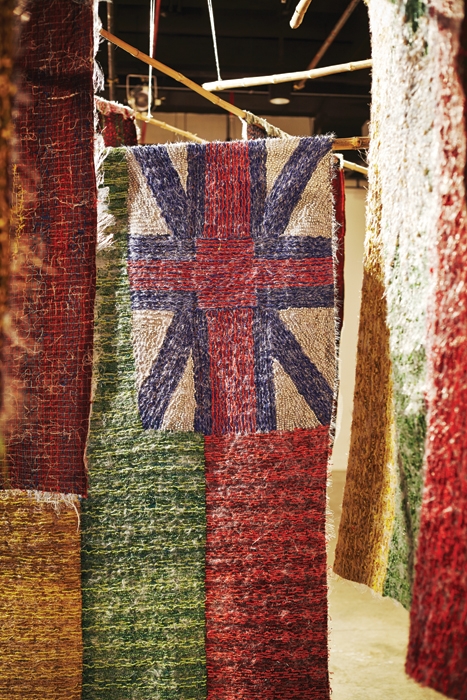The Festival of Arts, Shiraz–Persepolis was an annual festival held in Iran. Accompanied by seminars and symposia, the multidisciplinary event, each edition of which was composed around themes such as ‘music’ or ‘ritual theatre’, might see musicians such as Sundaram Balachander and Hasan Kassai rubbing shoulders with Yehudi Menuhin and Karlheinz Stockhausen. With significant contributions from Africa and South Asia, the festival aimed at erasing distinctions between periphery and centre. Inaugurated in 1967, the event was cancelled in the run-up to the Iranian Revolution, having cycled through 11 editions. Its archives remain banned in Iran, but at this year’s fourth edition of the biennial Dhaka Art Summit (DAS), where the directors of not-for-profits from Hong Kong, Vietnam and Sydney rub shoulders with the directors of MoMA and Tate, the festival was briefly resurrected in the form of a fascinating documentary exhibition curated by London-based Vali Mahlouji (via his nonprofit Archaeology of the Final Decade) and titled A Utopian Stage.
There’s a sense that the 2018 DAS, which takes a hybrid form combining exhibitions, lectures, workshops and conferences that seek to explore local (which here is a concept that expands beyond Bangladesh to encompass South and Southeast Asia) and international issues that circulate around the form, content and distribution of contemporary art and its histories, is entering a reflexive moment, exploring precedents and trying to excavate its own imagined roots. Visitors to the event were greeted by Dhaka-based Reetu Sattar’s Harano Sur (Lost Tune) (2016), a cacophony of harmoniums operated by musicians arranged on a scaffold around the atrium of the Shilpakala Academy (Bangladesh’s national academy of fine and performing arts, in which the DAS is housed). It conveys what I’m told is a lost sound of Bangladesh (where harmoniums used to be a household instrument) being resurrected, and a sense of place asserted. But the work also contains a trace of contemporary circulations and art networks. It was originally performed outside the Shilpakala Academy at the 17th Asian Art Biennale in December 2016; the work will travel to the Liverpool Biennial later this year.
During the DAS (founded by Rajeeb and Nadia Samdani, an industrialist-collector-philanthropist couple based in Dhaka, who are currently constructing a new arts centre in Sylhet, in the northeast of Bangladesh), Shilpakala hosts around ten discrete exhibitions, each unfolding as you ascend the academy tower. The Asian Art Biennale, founded in 1981, was the subject of one of them. Set up following a visit to The Asian Art Show (a predecessor to the Fukuoka Triennale) in Japan, by the then-director of Shilpakala, painter Syed Jahangir, it is addressed here in The Asian Art Biennale in Context, which contained various works from previous editions of the biennale, many of them experiments with abstraction (which occasionally make you feel that the past is another country), but the whole indicative of desires for the kind of decolonised internationalism that DAS as a whole seeks to achieve.
The figure of Rabindranath Tagore, the white-bearded Nobel Prize-winning pacifist polymath whose compositions were used to create both the Indian and Bangladeshi national anthems, was another ghost strategically resurrected to haunt the opening day of the summit. He was directly invoked in the Otolith Group’s performance lecture (part of Bearing Points, an exhibition curated by DAS Chief Curator Diana Campbell Betancourt), which touched on Santiniketan, the idealistic, syncretic, rural academy-cum-ashram in West Bengal founded by Tagore’s father and vastly expanded by the son, and in a discussion titled ‘Another Asia’ (which I was moderating), via Rustom Bharucha’s analysis of inter-Asia exchange at the turn of the twentieth century, focused on the universalist Tagore’s curious relationship with the influential Japanese curator, art historian and imperialist Okakura Tenshin and the discord between their opposing ideals of Pan-Asianism.
All of the above set the platform for a series of exhibitions of contemporary works that track a path from utopianism to decolonisation, while also addressing current concerns about migration, repression and environmental destruction. If you wish to be critical, there is a definite sense in which the Shilpakala Academy is, for the nine days of the summit (full disclosure: I was present for less than half of it), transformed into an ivory tower of culture. While art professionals from around the world trawl through its displays, and its corridors, stairwells and lecture theatre hum with a discourse about migration, integration, egalitarianism, censorship and pan-culturalism, there is poverty, inequality, congestion, a migrant crisis and evidence of the residual effects of ecological disaster outside its walls. Why bother with representation (or the filter of art) when what’s being represented is right there? (Crucially, of course, this is a problem for art in general rather than DAS in particular.) Thai artist Jakkai Siributr’s The Outlaw’s Flag (2017, also part of Bearing Points), for example, is a series of flags created from the debris left behind on beaches in Myanmar and Thailand that are migration points for the Rohingya people, a large number of whom are currently in Bangladesh. What the summit as a whole revealed (particularly via curator Sharmini Pereira’s One Hundred Thousand Small Tales, an incredibly moving exhibition of art produced during and in the wake of Sri Lanka’s civil war-cum-genocide, and Cosmin Costinas’s A Beast, A God, A Line, which traces histories and networks of colonial oppression and their postcolonial unravelling in the Asia Pacific region), is that you can’t know where you are unless you can begin to trace how you got there.
From the Spring 2018 issue of ArtReview Asia
